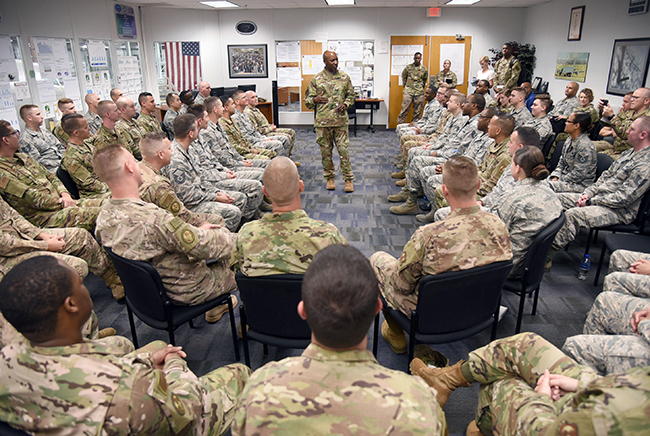
CMSAF Kaleth Wright visited several units at Tinker AFB, Okla., and toured the 137th Special Operations Wing at Will Rogers ANGB, Okla., on July 30-31. Air Force photo by Kelly White.
The Air Force is moving toward an “indefinite enlistment” process—removing the requirement for senior enlisted personnel to regularly re-enlist after a certain number of years. Chief Master Sergeant of the Air Force Kaleth Wright wants to push the proposal further.
Currently, most senior enlisted airmen have to re-enlist every four years in a lengthy, cumbersome paperwork approval process that culminates in a swearing-in ceremony. To avoid putting airmen who have already proven their commitment to serve through an unnecessary process, the Air Force wants to scrap the re-enlistment requirement after 15 years in service.
After 15 years, airmen would instead continue serving until they file for retirement or reach their high year of tenure, when they must separate or retire. Air Force officials expect to decide whether to approve the change this fall, Wright told airmen in recent base visits.
Wright was on board with the 15-year cutoff when he announced the potential shift in 2017.
“I believe at 15 years of service, most of us are plugged in, dedicated and ready to roll,” Wright said at the time. “We’re still doing the research. We like to go slow to go fast, to make sure we understand all of the benefits."
But during recent visits with airmen, Wright asked: If 15 years is no problem, why not sooner
Take the Army, for instance. The land service has a similar indefinite-enlistment procedure that is no longer a requirement after 12 years. Wright has suggested that number as well, to follow the Army’s lead.
Wright is also looking at another change for senior non-commissioned officers later in their career. To help retain employees and boost job satisfaction, the Air Force is looking at a dual track that lets senior NCOs choose to remain in a hands-on job or to focus on office work. For example, once an airman hits a higher enlisted rank, they can pick a “technical track” to keep turning wrenches on airplanes and avoid office work. Or, an airman can take the more managerial track. Either option aims to give senior NCOs more control over how their careers play out.
The dual track would be similar to the process in the Marine Corps, where enlisted personnel at the rank of gunnery sergeant can choose between continuing their career as a master sergeant or a first sergeant, with the latter focusing on personnel leadership. That process begins at the rank of E-7, but Wright is considering having the Air Force version begin at E-6.
The proposal is similar to Air Mobility Command’s “flying-only” career track, which lets pilots finish their career in a cockpit instead of shifting into staff positions.